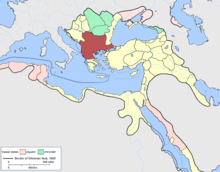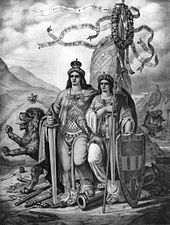Eastern Rumelia
Eastern Rumelia ( Ottoman روم الى شرقى İA Rûmeli-i Şarkî , Bulgarian Източна Румелия Istotschna Rumelija , Greek Ανατολική Ρωμυλία Anatoliki Romilia ) was an autonomous province of the Ottoman Empire in the south of today's Bulgaria . It was created by the Treaty of Berlin in 1878. It lasted until 1885, when a bloodless revolution in Philippopolis (today Plovdiv ) put an end to the special existence of this area and it was annexed to the Principality of Bulgaria, which was also created in 1878 . Eastern Rumelia comprised the Upper Thracian Plain , Upper Thrace between the Balkans , Rhodope Mountains and the Black Sea coast with the then capital Plovdiv. Bulgarian , Greek and Turkish were official languages, but since the Bulgarians made up the vast majority, the last two could not prevail.
Emergence

Eastern Rumelia was established because the European powers wanted to prevent a great Bulgaria on the model of the Conference of Constantinople of 1877 and the Peace of San Stefano of 1878. A large Bulgarian empire would on the one hand have been under Russian influence, which was supposed to be contained, and on the other hand would have been unilaterally at the expense of the Ottoman Empire and would have had a particularly negative impact on trade relations with the Ottomans. While the simultaneously created Principality of Bulgaria was under Russian influence, Eastern Rumelia was conceived as a vassal of the Sublime Porte . The name of Eastern Rumelia took up the Ottoman name Rumelia , which stood for all European parts of the empire (such as Macedonia , Thrace , the European districts of Istanbul ).
The population was 975,030 in 1885. These included 681,734 Christian Bulgarians , 200,498 (over 20%) Turks and Muslim Bulgarians, 53,028 (around 5%) Greeks , 27,190 (2.7%) Gypsies , 6,982 Jews , 1,865 Armenians and 3,733 people of other nationalities. In Philippopel (1900: 15% Turks) and some other cities, the Turks made up the significant minority. The area was in six departments ( Philipp Opel , Eski Zagra , Chasköi , Sliven , Tatar-Bazardschik and Burgas divided), which in turn made a total of 28 cantons ( okolia passed). The largest department was Philippopel with around 187,000 inhabitants, the smallest Burgas with around 88,000. The largest city, Philippopel (now Plovdiv), was designated the capital of the province.
The administration was to be entrusted to a Christian governor general appointed by the Porte with the consent of the great powers for a period of five years . Between October 1878 and May 1879 the Russian general Stolypin administered the area, from May 1879 to May 1884 Prince Aleksandar Bogoridi and then Gavril Krastewitsch administered the area. The gate received 30% of the national income and a share of the income from customs duties .
Association with Bulgaria

However, this artificial construction of Eastern Rumelia did not last. This was also due to the fact that the Hohe Pforte did not approve most of the budgets and laws approved by the state parliament and thus caused displeasure in the population of Eastern Rumelia. Conservatives and radicals fought each other in the state parliament, while Russian, Turkish and Western influences alternated in the administration. In addition, there was the dissatisfaction of the Bulgarian population in Eastern Rumelia and Macedonia, as well as that in the neighboring Principality of Bulgaria against the resolutions of the Berlin Treaty. For this reason, the Kresna-Raslog uprising broke out in Macedonia as early as 1878 .
In eastern Rumelia, on the other hand, clubs were set up which, under the guise of gymnastics, helped young men to receive military training. In neighboring Bulgaria, too, there was a strong current of national circles under Prince Alexander von Battenberg , which aimed at expanding the state territory to all areas of the Balkans inhabited by Bulgarians (which had been denied by the Berlin Treaty).
In this context, 1885 in Philipp Opel, the Bulgarian Secret Central Revolutionary Committee ( BGZRK , Bulgarian Български таен централен революционен комитет ) of Sahari Stoyanov , Kosta Panica , Ivan Andonov , Todor Gatew , Ivan Stojanowitsch , Georgi Stranski and other, mainly officers of the militia Eastern Rumelia founded. Many of the members had already fought against the Ottoman Empire in the uprisings of 1875/76 and in the Russo-Ottoman War from 1877 to 1878 for Bulgaria's independence. The committee was built on the model of the Inner Revolutionary Organization and aimed at the simultaneous liberation of Macedonia and Eastern Rumelia from Turkish rule and the amalgamation of all Bulgarian areas. The formation of a confederation of all Balkan states was pursued as a long-term goal . Because of the limited resources, it was decided to venture a revolt in Eastern Rumelia. The preparations for an uprising were unofficially supported by the neighboring Principality of Bulgaria. The BGZRK set September 6, 1885 as the reference date.
Late in the evening of September 5th, Jul. / September 17, 1885 greg. Gavril Krastewitsch was overthrown by a popular coup by BGZRK militia officers led by Danail Nikolaev . The next day an interim government was set up under the leadership of Georgi Stranski. The new cabinet proclaimed the immediate amalgamation of the autonomous Ottoman province with the Principality of Bulgaria. The People's Party of Eastern Rumelia , which is close to Russia, spoke out against this . The Ottoman Empire limited itself to protest notes instead of sending troops to restore the contractually agreed status quo ante . Bulgaria's Prince Alexander von Battenberg immediately traveled to Eastern Rumelia after receiving a telegram. Already on September 8th July / September 20, 1885 greg. he was staying in Philippople.
Serbian-Bulgarian War
Austria-Hungary wanted to prevent the events in eastern Rumelia from spilling over to Macedonia . It signaled its backing to the Kingdom of Serbia , allied with him , which openly opposed the Bulgarian action. Russia, too, was hostile to the expansion of the Bulgarian territory and its rulers. The Serbian King Milan Obrenović declared July 1 with this backing . / November 13, 1885 greg. Bulgaria the war. His military assumed a light armed conflict because most of the Bulgarian troops were on the Turkish border. However, the announcement of the Serbian declaration of war led to great national outrage in Bulgaria.
Volunteers who were quickly called together did damage to the invading forces as partisans. Nonetheless, the fighting Serbian army moved within almost twenty kilometers of the Bulgarian capital Sofia . On November 5th, Jul. / November 17th greg. the decisive battle of Slivnitsa began with the Bulgarian army, which ended after three days with a Serbian defeat. When the Bulgarians undertook a campaign against Serbia and advanced towards Niš , Austria-Hungary intervened with a war threat if the army did not withdraw into Bulgarian territory. Bulgaria therefore refrained from any further advance and concluded an armistice with Serbia. The war officially ended with the Peace of Bucharest on February 19th July. / March 3, 1886 greg. ; mutual territorial claims were excluded.
Further development
By the Tophane contract of March 24th jul. / April 5, 1886 greg. the union of the Principality of Bulgaria with Eastern Rumelia was internationally recognized in autumn 1885. The principality paid the Ottoman Empire an annual tribute of 2,951,000 francs to replace eastern Rumelia . Sultan Abdülhamid II had appointed the Bulgarian prince as governor general of Eastern Rumelia on February 2, 1886. This was a compromise solution in which the Ottoman sovereign rights were officially preserved.
After the Treaty of Bucharest (March 3, 1886), the Russian Tsar Alexander III refused . To recognize Alexander I as ruler of enlarged Bulgaria. At the instigation of Russia, a group of pro-Russian officers launched a coup against the Bulgarian Prince Alexander I and forced him to abdicate on August 9, 1886. He was then deported to Russia outside of the country. With the support of the Bulgarian parliamentary president Stefan Stambolow , who opposed the coup with the help of the military, Alexander was able to return to Bulgaria and briefly to the throne. On September 7, 1886, however, he finally renounced the rule because he no longer enjoyed the confidence of the Russian tsar. After long internal political turmoil, Ferdinand von Sachsen-Coburg and Gotha was elected as his successor in 1887.
Governors General of Eastern Rumelia
- Provisional General Arkadi Dmitrijewitsch Stolypin (1878 to 28 May 1879) (father of Pyotr Arkadjewitsch Stolypin )
- Aleksandar Bogoridi (May 28, 1879 to May 1884)
- Gavril Krastewitsch (May 1884 to September 6, 1885)
- Prince Alexander I of Bulgaria (April 17, 1886 to September 7, 1886)
- Prince Ferdinand I of Bulgaria (July 7, 1887 to October 5, 1908)
literature
- RJ Crampton: A Concise History of Bulgaria. Cambridge University Press, Cambridge 2005, ISBN 978-0-521-61637-9 .
- István Diószegi: The Problem of Eastern Rumelia in Austro-Hungarian Foreign Policy 1878–1879. In: Christo Choliolčev (Ed.): National Revolutionary Movements in Southeastern Europe in the 19th Century. Verlag für Geschichte und Politik, Vienna 1992, ISBN 3-486-55961-3 , pp. 202–210.
- Gabriel Goltz: A Christian-Islamic Controversy About Religion, Nation and Civilization. The Ottoman-Turkish periodicals of the German Orient Mission and the Balkan newspaper in Plovdiv. In: Studies on Oriental Church History. LIT Verlag, Münster 2002, ISBN 3-8258-6434-0 .
Web links
- Vladimir Vladimirov: September 6th - Unification Day . ( Memento from January 15, 2013 in the web archive archive.today ) ( Bulgarian National Broadcasting )
Individual evidence
- ↑ Eastern Rumelia . In: Meyers Konversations-Lexikon . 4th edition. Volume 12, Verlag des Bibliographisches Institut, Leipzig / Vienna 1885–1892, p. 554.
- ↑ Gabriel Goltz: A Christian-Islamic Controversy About Religion, Nation and Civilization. The Ottoman-Turkish periodicals of the German Orient Mission and the Balkan newspaper in Plovdiv 1908-1911. Lit, Münster 2002, ISBN 3-8258-6434-0 , p. 7.
- ↑ rdp-bg.org
- ↑ Slivnitsa . In: Meyers Konversations-Lexikon . 4th edition. Volume 14, Verlag des Bibliographisches Institut, Leipzig / Vienna 1885–1892, p. 1032.
- ^ Rudolf von Albertini (ed.): Handbook of European history. Volume 6: Europe in the age of nation states and European world politics up to the First World War. Klett-Cotta, Stuttgart 1968 ISBN 3-8002-1111-4 , p. 555.
- ↑ Simeon Radew , Trajan Radew: The builders of modern Bulgaria . Volume 1, Volume 2 (1910–1911) and Volume 3 (2008), ( Bulgarian Строителите на съвременна България. Том 1 )



